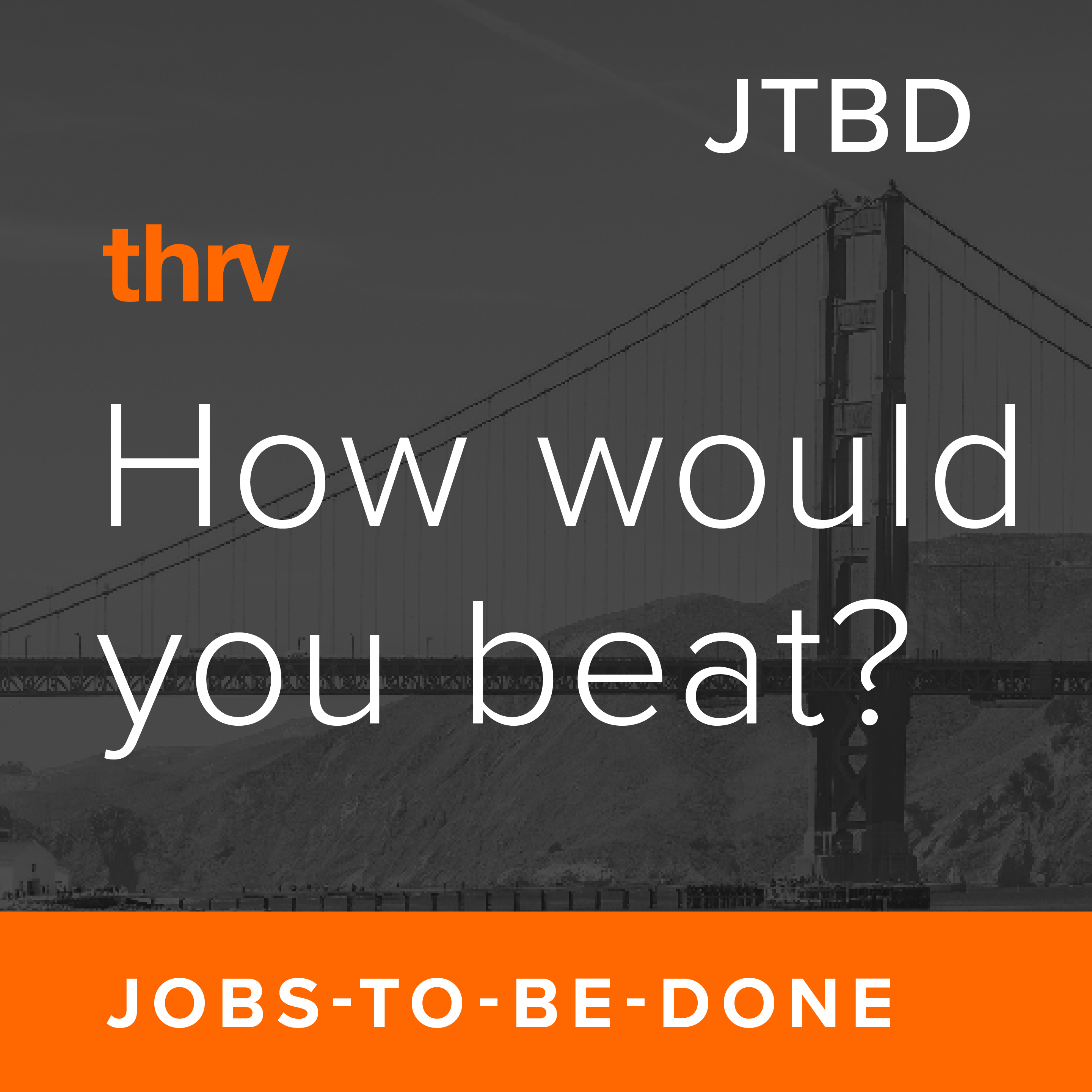Equity value drivers (from customer progress)
What are equity value drivers from a customer progress perspective?
Equity value drivers from a customer progress perspective are the key factors that create sustainable business value by helping customers advance in their Jobs To Be Done. Unlike traditional equity value drivers that focus primarily on internal metrics like margin improvement or cost reduction, this approach centers on how effectively a company helps customers make progress in their lives or work.
From this perspective, equity value is created when companies develop superior capabilities to:
- Identify customer jobs and unmet needs
- Create solutions that satisfy those needs better than alternatives
- Build sustainable advantages in job satisfaction that competitors cannot easily replicate
This approach recognizes that long-term equity value ultimately depends on creating, delivering, and capturing customer value more effectively than competitors.
Why focus on customer progress as an equity value driver?
Traditional approaches to equity value creation often focus on internal factors like operational efficiency, without sufficient attention to the market-facing factors that drive sustainable growth. A customer progress approach offers several advantages:
1. Sustainable competitive advantage
When companies deeply understand customer jobs and develop unique capabilities to satisfy them, they create competitive advantages that are difficult to replicate. This leads to more defensible market positions and stronger equity value.
2. Premium pricing power
Companies that help customers make progress on important, underserved needs can command premium prices. This pricing power directly enhances margins and equity value.
3. Reduced customer acquisition costs
Solutions that clearly help customers make progress on their jobs generate stronger word-of-mouth and referrals, reducing customer acquisition costs and improving unit economics.
4. Higher customer lifetime value
When products effectively help customers accomplish their jobs, retention improves and expansion opportunities increase, driving higher lifetime value and more predictable revenue streams.
5. Multiple expansion
Public and private markets typically reward companies that demonstrate superior understanding of customer needs and ability to satisfy them with higher valuation multiples, directly enhancing equity value.
What are the key equity value drivers from customer progress?
1. Unmet Need Identification Capability
The ability to systematically identify and quantify unmet customer needs:
- Job mapping methodologies that reveal all steps in customer jobs
- Need measurement systems that quantify importance and satisfaction
- Segmentation approaches that identify underserved customer groups
- Economic analysis tools that calculate the value of need satisfaction
- Opportunity sizing frameworks that prioritize the highest-value needs
Companies with superior capabilities in this area identify high-value opportunities that competitors miss.
2. Solution Development Effectiveness
The ability to create solutions that satisfy unmet needs better than alternatives:
- Concept development processes that target specific unmet needs
- Validation methodologies that verify job execution improvement
- Rapid iteration approaches that optimize need satisfaction
- Resource allocation systems that focus on high-value opportunities
- Technology selection practices that maximize job satisfaction
Companies with superior capabilities in this area create solutions that deliver more customer value more quickly.
3. Need Satisfaction Advantage
The degree to which a company's solutions satisfy customer needs better than alternatives:
- Speed advantage in key job steps
- Accuracy advantage in critical decisions
- Effort reduction advantage in complex processes
- Comprehensiveness advantage across the entire job
- Integration advantage with related jobs and systems
The greater this advantage, the stronger the company's market position and equity value.
4. Value Capture Effectiveness
The ability to extract fair value for the progress enabled:
- Pricing models aligned with value created
- Customer segments targeted based on willingness to pay
- Value communication systems that articulate progress enabled
- Sales processes that demonstrate job execution improvement
- Success metrics that quantify value delivered
Companies with superior capabilities in this area achieve higher margins and returns on investment.
5. Sustainable Differentiation Durability
The ability to maintain advantages in job satisfaction over time:
- Continuous job monitoring to identify evolving needs
- Innovation pipelines focused on emerging job challenges
- Process improvements that enhance job satisfaction
- Data advantages that improve job execution
- Network effects that increase value with scale
The more durable these advantages, the more stable and valuable the company's equity.
How do we measure equity value drivers from customer progress?
Job Satisfaction Metrics
These metrics measure how well a company helps customers execute their jobs:
- Job success rate - The percentage of customers who successfully accomplish their job
- Time to job completion - How quickly customers can execute their job
- Job accuracy - How precisely customers can complete critical job steps
- Job effort - How much mental and physical effort is required
- Job completion confidence - How certain customers are of successful execution
Improvements in these metrics directly correlate with stronger market position and equity value.
Market Position Indicators
These metrics reveal a company's competitive position in helping customers make progress:
- Need satisfaction advantage - How much better the company satisfies key needs compared to competitors
- Win rate - The percentage of competitive situations where the company's solution is selected
- Price premium - How much more customers will pay compared to alternatives
- Market share in target segments - Penetration among customers with specific job challenges
- Share of wallet - The percentage of related job spending captured
Stronger performance on these metrics indicates more defensible market positions.
Financial Value Metrics
These metrics connect customer progress to financial outcomes:
- Customer acquisition efficiency - Cost to acquire customers relative to lifetime value
- Net revenue retention - Growth from existing customers through expanded usage
- Gross margin - Profitability of revenue, often enhanced by value-based pricing
- Innovation ROI - Return on investments in new capabilities that enhance job satisfaction
- Valuation multiple - How the market values the company relative to peers
These metrics translate customer progress capabilities into financial performance and equity value.
Strategic Position Assessments
These assessments evaluate the sustainability of customer progress advantages:
- Job insight depth - How thoroughly the company understands customer jobs compared to competitors
- Need satisfaction capabilities - The unique resources and processes for addressing customer needs
- Innovation pipeline strength - The potential impact of planned enhancements on job satisfaction
- Customer data advantages - Proprietary information that improves job satisfaction capabilities
- Ecosystem position - How the company's solution connects to related jobs and systems
Stronger strategic positions correlate with more sustainable equity value.
How do private equity firms create equity value through customer progress?
1. Due diligence focused on jobs and needs
Forward-thinking private equity firms assess acquisition targets based on:
- How well they understand customer jobs and unmet needs
- The size of opportunity from addressing underserved needs
- Their competitive advantages in satisfying key job steps
- The sustainability of these advantages over the investment horizon
- The potential to enhance job satisfaction through strategic improvements
This job-based due diligence identifies opportunities that traditional approaches might miss.
2. Value creation planning centered on customer progress
Post-acquisition value creation plans prioritize:
- Addressing high-impact unmet needs in customer jobs
- Developing capabilities that enhance job satisfaction
- Aligning product roadmaps with customer job priorities
- Refocusing marketing and sales on job-based value
- Building data assets that improve job insights
These plans directly connect operational improvements to market outcomes.
3. Strategic add-ons that enhance job satisfaction
M&A strategies target acquisitions that:
- Address adjacent steps in customer jobs
- Provide complementary capabilities for key job steps
- Bring unique technologies that improve job execution
- Add data that enhances job performance
- Extend reach to new customer segments with similar jobs
This approach creates strategic value beyond simple financial engineering.
4. Operational improvements linked to job performance
Operational initiatives focus on:
- Streamlining processes that directly impact customer job execution
- Building capabilities that address high-value unmet needs
- Reallocating resources from low-impact to high-impact job areas
- Enhancing systems that improve job satisfaction measurement
- Developing talent with deeper job insight capabilities
These improvements create sustainable competitive advantages rather than temporary cost reductions.
5. Exit positioning based on job satisfaction leadership
Exit narratives emphasize:
- Demonstrated leadership in satisfying key customer jobs
- Quantified improvements in job execution metrics
- Sustainable advantages in addressing high-value needs
- Strategic positioning for emerging job requirements
- Growth potential from expanding to adjacent jobs
This positioning attracts buyers and public markets willing to pay premium multiples.
What are common challenges in driving equity value through customer progress?
Short-term focus undermining long-term value
The pressure for quick wins can lead to prioritizing tactical improvements over strategic capabilities that create sustainable value. Balance is required between immediate operational improvements and building enduring job satisfaction advantages.
Inadequate customer job insights
Many companies lack deep understanding of customer jobs and unmet needs, making it difficult to identify the highest-value opportunities. Investments in job research capabilities are often required before other initiatives can succeed.
Organizational resistance to customer-centric approaches
Traditional functional structures and metrics can impede adoption of customer job perspectives. Cultural and organizational changes are often necessary to align the company around customer progress.
Difficulty measuring job satisfaction impact
While financial metrics are well-established, many companies struggle to implement effective measurement of job satisfaction and its business impact. Building these measurement systems is a critical enabler of customer progress initiatives.
Competitive response undermining advantages
As competitors adopt similar approaches, initial advantages in job satisfaction may erode. Continuous innovation and development of proprietary job satisfaction capabilities are necessary to maintain value creation potential.
How thrv helps drive equity value through customer progress
thrv provides specialized methodologies and tools to help companies and private equity firms create equity value through superior customer job satisfaction. The thrv platform enables systematic identification of high-value unmet needs, development of solutions that address these needs better than alternatives, and measurement of job satisfaction improvements that drive market leadership.
For private equity firms seeking to create value beyond traditional cost-cutting and financial engineering, thrv's approach provides a powerful framework for identifying acquisition targets with strong job satisfaction potential and developing value creation plans centered on customer progress. The result is stronger competitive positioning, superior growth, and higher exit multiples—all derived from helping customers make meaningful progress in their jobs.




